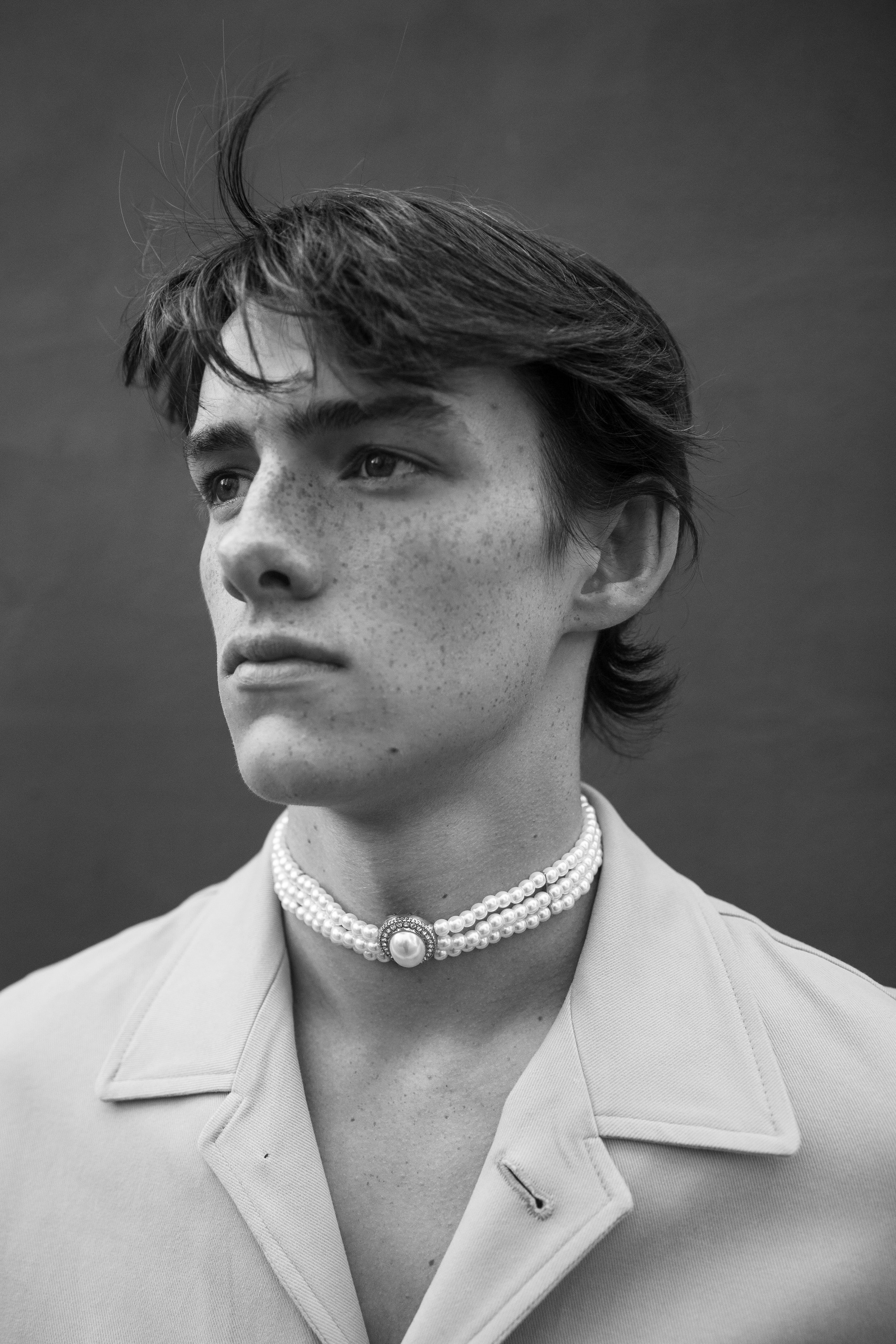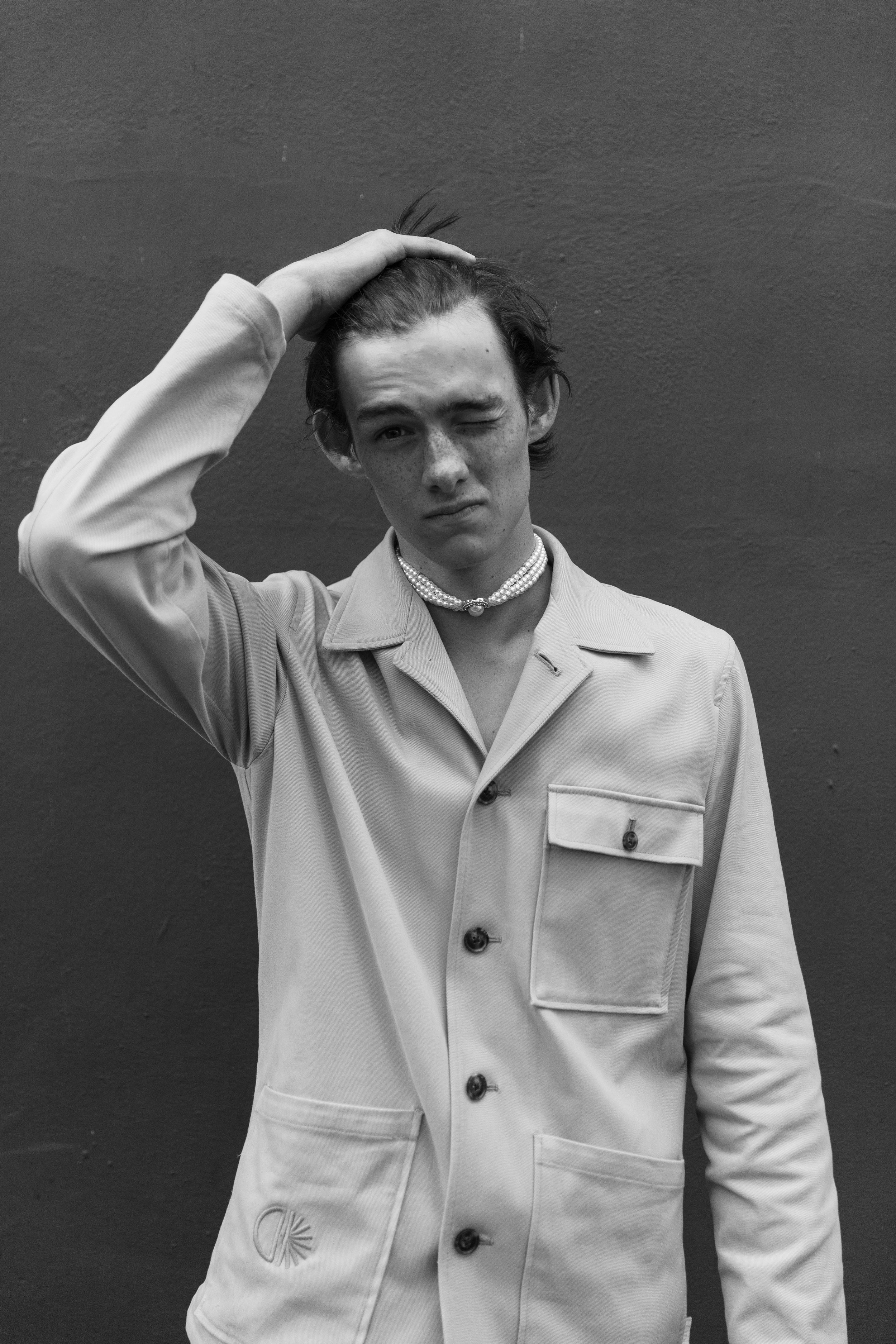The boys with the pearl necklaces
Right now, pearls are a boy’s best friend. They’re gracing the necks of guys everywhere from posterboy Harry Styles to the French teenager I spotted in the Eurostar departures lounge. Adding flair and character, a string of pearls is the latest must have piece of jewellery for men since Normal People’s Connell blessed our screens wearing that silver chain. A step up from the simplicity of Connell’s hardware, the pearl necklace is meant to cause a stir. Flamboyance is this tiny mollusc's USP and men everywhere are lapping them up. The question is, is it in a bid to liberate themselves from outdated modes of masculinity or to cement their hetero hyper-masc status in an ever identity evolving world?
Because, what does it mean to ‘dress like a man’? According to the runway recently: extremely dull. But it hasn’t always been this bad. Men’s fashion was once just, if not more, extravagant as womens. Frills, ruffles, lace, and embellishment all served as flamboyant signifiers of power, wealth and masculinity. Pieces generally considered ‘feminine’ today originated in the wardrobes of 16th century royalty and statesmen who were all considered beacons of hyper-masculinity. Maleness was identified in different ways, by the number of pearls you wore or how high your kitten heels were. Gender is complicated and its expression has never been fixed, not then and not now. From Sir Walter Raleigh and Sir Elton John, the pearl necklace has made a historic comeback at a time when menswear needs it most.
But, why now? Is it too easy to say the boys were bored? Bored of their wardrobes and bored of the rigid gender binary which, in the end, stifles everyone. Covid-19 took so much away from all of us but its gift was time. Time to think, to take stock of our lives and identities. When some resemblance of normality resumed, almost two years later, the landscape of fashion, gender expression and society as a whole had shifted. At the same time, many high profile men and non-binary people were playing with their gender expression and publically critiquing the archaic ideas we’d accepted as gospel. However, the homophobic undertones of what it means ‘to be a man’ are embedded in popular culture and consciousness making the task to unravel and unlearn what masculinity is and isn’t no easy feat. It’s bound to feel complicated when your youth was spent hyperventilating about whether your new piercing was on the ‘gay’ ear but just yesterday, Harry Styles performed to a sold out stadium wearing sunglasses, nail polish and a feather boa. But maybe it feels so complicated because it fundamentally makes no sense and the attempt to identify a ‘right’ or ‘wrong’ way to be rather than accepting that there are no rules is fruitless.
The Harry duo (Styles and his stylist, Lambert) have brought this ‘no rules’ mentality to the masses, transforming Harry’s look from one direction to an eclectic mish-mash of campy flamboyance that pulses with excitement. As the first man to appear solo on the cover of American Vogue - wearing a lacy blue Gucci dress - there has never been a time where it was more acceptable for Tom, Dick AND Harry to have fun with fashion. As Styles says himself, “Clothes are there to have fun with and experiment with and play with. What’s really exciting is that all of these lines are just kind of crumbling away. When you take away ‘There’s clothes for men and there’s clothes for women,’ once you remove any barriers, obviously you open up the arena in which you can play.” Not that his cover was without backlash. Apart from the yawn-inducing ‘bring back manly men’ comments on Twitter, many people felt that choosing Harry as ‘the face’ for fashion fluidity undermined those who were not white, cis or straight out of a conversation they’d been having for decades. In an unrelated but extremely relevant podcast episode, Vietnamese American Poet, Ocean Vuong, talks about noticing this trend “for very straight identifying cis het boys to wear pearls” remarking “that would be a death note when I was growing up for a boy to wear pearls, and to do it so proudly.”
The LGBTQ+ community, particular those of colour, have been deconstructing the gender binary for as long as it has existed. Gender as performance and playing ‘dress-up’ with pearls isn’t revolutionary unless you’re a cis straight man who isn’t clued up on his fashion history. Perhaps instead of subverting masculinity, the recent pearl comeback actually cements traditional gender roles; masquerading as something more progressive than it actually is? Take Hip Hop for example. A genre so often defined by hypermasculinity through it’s braggadocio bars and notoriously homophobic undertones but one that regularly embraces femme style. Kid Cudi wearing a Virgil Abloh dress on SNL, Young Thug in Molly Goddard, Kanye West in a leather kilt, are these one-off spectacles meant to shock or considered deconstructions, paving the way for greater gender fluidity in the industry? Similarly to 16th century statesmen, rappers performing in designer dresses, skirts and decked out in pearls is a status symbol above all else. Symbolising their power, wealth and worldliness, it’s in this way that the pearl's meaning is co-opted to symbolise secure heterosexulaity and masculinity during a time of fluid gender expression. So no, it’s not revolutionary but it’s inadvertently having revolutionary effects in mainstream consciousness. Skirts may still be a step too far but pearls, as sartorial leaps go, are less scary mainly because they’ve become a lot less controversial with wear.
It’s an immutable law of physics and fashion that for every action there is an opposite and equal reaction. Pearls are having a(nother) moment but this is unlikely to last forever. The fashion industry's ravenous appetite for new makes the death of trends inevitable but the same doesn’t apply to the meanings behind them. Pearls may be forgotten but the attempt to refashion masculine ideals will hopefully remain. That’s not to take away the significance of the accessory’s popularity but to give a realistic forecast of what could come next. Menswear especially needs to cling on to the pearl’s playfulness if it's to stop further decades of bland design stifled by rigid gender stereotypes in its tracks. Progress is percolating but it’s impossible to fully unravel centuries of conditioning in a single lifetime. The boys are challenging the status quo one unlikely accessory at a time whether they’re doing so consciously or not. Who knows if it’s to liberate themselves from outdated modes of masculinity or cement their security within it? Evolution is happening either way.





